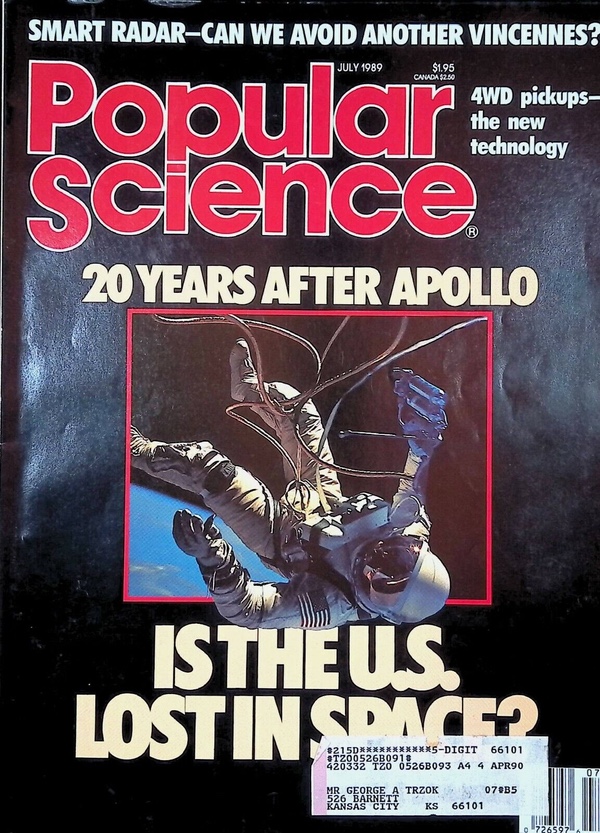Aiming for the Moon, crashing on Earth: The rise and fall of the 1989 Space Exploration Initiative (part 2)by Dwayne A. Day
|
| A former council staff member later admitted that they used Wood’s proposal to “scare the pants off of NASA,” not because it was necessarily realistic. |
One of the alternative plans that the panel heard about came from Lowell Wood, a scientist at Lawrence Livermore National Laboratory and protégé of Edward Teller. He was known as the creator of Brilliant Pebbles, a plan for a fleet of space-based missile interceptors that had produced much artwork but little hardware. Wood had previously pitched a radical space exploration plan at an academic conference a year before. Wood’s proposal involved inflatable spacecraft and the use of other unconventional techniques. It would have bypassed NASA completely and relied on ignoring traditional government procurement procedures. Wood’s estimate was that a program using his approach and including both Moon and Mars missions could be done for around $10 billion in ten years, albeit with substantially increased risk. One calculation was that there was a 10% chance of a fatality during the flights, which Wood considered acceptable, although observers noted that he would not be flying on the mission himself. One critic in NASA labeled Wood’s inflatable spacecraft plan “Brilliant Condoms.”
Faced with NASA’s $541 billion proposal on the one hand and Wood’s significantly cheaper proposal on the other, the panel determined that more study was needed. Many members were also critical of NASA for what they viewed as the totally unrealistic approach in the 90-Day Study. The panel recommended that the National Academy of Sciences study the issue further.
Despite his “cheaper” alternative, Wood had no established track record at producing affordable space hardware, and his approach was radical and totally unprecedented. There is no reason to believe that it would have cost as little as he claimed or even been workable. But his proposal did demonstrate that there were ideas other than the ones NASA was considering, and that costs might not have to be as high as the agency claimed. A former council staff member later admitted that they used Wood’s proposal to “scare the pants off of NASA,” not because it was necessarily realistic.
In fact, Wood had a small group of ideological followers who circulated between the National Space Council and the Strategic Defense Initiative Organization. They felt that space exploration did not have to be nearly as expensive as NASA claimed. They soon began looking for innovative ways of making this point. As Thor Hogan wrote in his 2011 book Mars Wars, there was contentious infighting over how to accomplish this goal.
By early 1990, Bush submitted a new NASA budget to Congress which called for a 24% increase in funding, much of it to pay for space station development. NASA was one of the few agencies to receive an increase in funds. In the same budget, the Office of Management and Budget projected a $100 billion federal deficit. The nonpartisan Congressional Budget Office, however, projected a $138 billion federal budget deficit.
Despite the strong criticism Bush faced from both the Congress and the press after he proposed his plan, and even though NASA continued to demonstrate an unwillingness both to establish clear priorities and search for innovative ways of achieving Bush’s goals, the president did not back away from SEI immediately. Bush made a speech in May 1990 at Texas Arts and Industries University in support of his new initiative, establishing 2019 as the goal for a human landing on Mars. When faced with a funding setback in the House in early June 1990, Bush indicated that he intended to fight for SEI. He declared that SEI was important to him, which in many ways made it a bigger target for his opponents.
By late June 1990 Congress zeroed out NASA’s SEI budget.
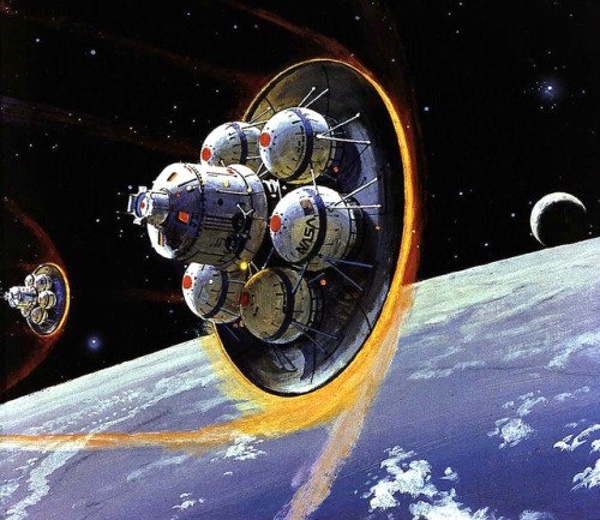 Famed space artist Robert McCall provided several illustrations for the 1986 report Pioneering the Space Frontier. That report called for an ambitious human spaceflight program, but came out soon after the Challenger accident cast doubt on NASA's abilities. |
Outreach and the search for lower costs
In May 1990, at the impetus of the National Space Council, NASA created Project Outreach to appeal for suggestions from outside the agency about how best to conduct SEI. The RAND Corporation was hired to gather the materials from the public. The panel appointed to collate the proposals was known as the Synthesis Group and was chaired by former astronaut and retired Air Force Lieutenant General Thomas Stafford. Project Outreach was a clear indication of the council’s lack of confidence in NASA’s approach to SEI. NASA Administrator Richard Truly was opposed to Project Outreach and feared that it undercut his authority.
Other factors also intervened to damage SEI. One of the major problems reportedly was that Truly actively campaigned in private against a program that his boss, the President of the United States, had endorsed in public. Truly was motivated by concern that SEI posed a threat to both the space shuttle and the space station. In addition, other factors damaged NASA’s image. In the summer of 1990, the agency suffered a series of setbacks, including hydrogen leaks on the shuttle and the Hubble Space Telescope’s flawed mirror. The press began to ask how NASA could explore the Moon and Mars if the agency could not properly check a telescope mirror or get its shuttles off the ground.
These problems prompted Mark Albrecht, the Space Council’s executive secretary, to urge Quayle to call for an outside review of the space program. The review, the Advisory Committee on the Future of the U.S. Space Program, was headed by the highly respected chairman of Martin Marietta, Norman Augustine. The Augustine Committee issued its report in December 1990, concluding that the civilian space program was not in such bad shape as its critics charged, but did urge that the space program be refocused to make science the center of NASA’s mission.
| In essence, what the Synthesis Group said was that although the original, highly unrealistic SEI plan did not need to be followed, and less ambitious goals could be substituted at first, there still were no inexpensive routes back to the Moon or on to Mars. |
The Augustine Committee relabeled SEI “Mission From Planet Earth,” and did not strongly endorse it. In fact, as Quayle later revealed in his memoirs, the Augustine Committee initially placed human exploration last on the list of missions that NASA should conduct, which would have been a stunning slap at Bush and the National Space Council. Quayle, Albrecht, and others objected and so the listing was eliminated from the final report. What the Augustine Committee did do was to propose that NASA adopt a “go as you pay” approach to human exploration of the solar system rather than an open-ended 30- or 34-year plan, and only propose projects that could reasonably be funded. The committee also recommended that NASA consolidate its exploration efforts into a single program-level Office of Exploration (replacing the previous Office of Exploration that served merely as an advisory office under the administrator). This new office would be headed by an Associate Administrator for Exploration.
In early 1991 Truly named Michael Griffin as the new Associate Administrator for Exploration. Griffin came to NASA after a successful stint in the Strategic Defense Initiative Organization, which for a period during the late 1980s and early 1990s had essentially been running its own small space program. Among his efforts, Griffin sought to pare down the lunar precursor missions that NASA would fly before sending humans to the Moon. The new proposed missions now included Lunar Resource Mapper, a 900-kilogram spacecraft that would be launched atop a Delta launch vehicle and carry spectrometers to detect minerals and elements on the Moon. It would be followed by Lunar Geodetic Scout, which would make stereo images of the lunar terrain and map the Moon’s gravity field. But Congress removed the funding for the small spacecraft, which many agency critics viewed as the camel’s nose under the tent leading to bigger and more expensive follow-on missions.
Although Griffin brought a new engineering philosophy to SEI, a “smaller, faster, cheaper” approach, he had a hard time selling that approach to Congress for numerous reasons, including the fact that by 1991 Congress no longer trusted NASA or the White House with anything having to do with further human space exploration beyond the projects already funded. Griffin also failed to communicate well with the head of NASA’s Office of Space Science and Applications, Leonard Fisk, and they both ended up proposing redundant programs on Capitol Hill.
In the summer of 1991—two years after Bush had initiated the Space Exploration Initiative—Stafford’s Synthesis Group issued its report which in some ways was a further disappointment to SEI proponents. America at the Threshold was another glossy study illustrated by Robert McCall. It was focused more upon architecture and infrastructure—the ways of conducting exploration missions—rather than the why, or ways of significantly reducing the costs.
Because they considered Earth-orbit construction too risky, the Synthesis Group stated that both Mars and lunar missions required a heavy-lift launch vehicle on the order of the Saturn V—an expensive undertaking. Furthermore, the report strongly favored the use of nuclear propulsion to send humans to Mars, which would also involve an expensive development program. In essence, what the Synthesis Group said was that although the original, highly unrealistic SEI plan did not need to be followed, and less ambitious goals could be substituted at first, there still were no inexpensive routes back to the Moon or on to Mars. NASA did not have the right approach to SEI, but there were no truly groundbreaking technologies even outside of NASA that would make human exploration of the Moon and Mars possible at low cost.
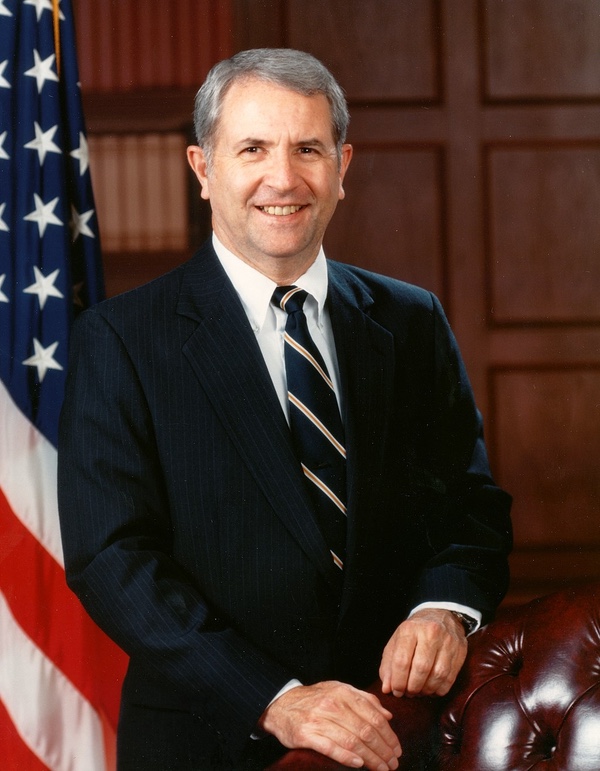 Richard Truly, eighth administrator of NASA and former astronaut, found himself embroiled in a bitter fight with the staff of the National Space Council in 1989 to 1992. The Space Council staff wanted NASA to return to the Moon while Truly was seeking to develop the space station and secure a fifth space shuttle orbiter. (credit: NASA) |
The release of the Synthesis Group’s report in summer 1991 led Space Council Chairman Dan Quayle to state that the end of the shuttle program was in sight. This resulted in a minor public spat with Truly, who was still advocating purchasing a fifth shuttle in addition to the one already on order to replace the Challenger. Truly refuted the Vice President and claimed that NASA had no plans to end the shuttle program.
The public dispute between Truly and Quayle was only the tip of the iceberg, because by this time Space Council staffers had determined that Truly was a major obstacle to transforming NASA into an organization capable of achieving future space exploration. They were now actively attempting, apparently without Quayle’s knowledge, to get President Bush to fire him. Several of these efforts failed, primarily because Truly proved skilled at playing the Washington political game, and both he and Bush were former naval aviators.
Unfortunately, the reputation of the space agency worsened at this time. There were problems with both the Galileo space probe and a NASA-managed project to build the United States’ next generation of weather satellites, not to mention continued management and design problems with the space station. In the spring of 1992, Bush finally did fire Truly in a messy and embarrassing way. The person the National Space Council got to replace him was Dan Goldin, who also brought the new “faster, better, cheaper” management approach to the agency. By this time, though, the point was moot. SEI was totally discredited. Even small lunar probes conducting legitimate science about the Moon were canceled by Congress.
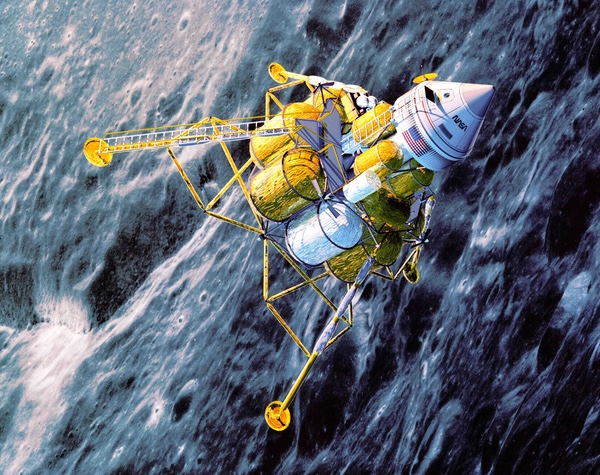 The large landing vehicle for the 1992 First Lunar Outpost proposal. This was one of the first detailed studies of a human return to the Moon after Apollo. It would have relied on mostly-prove technologies and bypassed the space shuttle. Although only a baseline proposal, not intended to be the method NASA would return to the Moon by 2001, it highlighted some of the major choices for such a mission: the use of existing technology vs. the development of new technologies that might be expensive in the short run but cheaper in the long run. (credit: NASA) |
First Lunar Outpost
After it was clear to virtually everyone that SEI was dead, the space agency began taking some steps towards outlining cheaper alternatives to achieving initial parts of the lunar goal—although “cheaper” was a relative term. Compared to the early estimates, NASA’s new alternatives were far less expensive, yet they remained far more than members of Congress were willing to support. But for the first time, NASA prepared a detailed outline of how the United States might return humans to the Moon.
| NASA had acquired three decades of experience since the LOR decision and the First Lunar Outpost architects felt that direct ascent was a more viable approach in 1992 than it was in 1962. |
In an effort to scale back the agency’s earlier plans for a permanently occupied lunar base, starting in 1991 NASA’s Office of Exploration had developed a different approach to a return to the Moon. This new concept was known as First Lunar Outpost (FLO) and contained several key differences compared to the 1989 architecture. First, the goal was no longer to establish a permanent base on the Moon virtually from the start, but to begin with limited surface operations. Second, the mission did not rely upon either the shuttle or reusable lunar transit vehicles. Third, the mission would completely bypass the space station. Finally, the plan did not rely upon unproven technology, such as reusable lunar transfer stages or the use of resources on the lunar surface.
FLO was formally unveiled by NASA in summer 1992. It was intended to serve as a detailed “baseline” proposal, not necessarily the final design. The purpose of the proposal was to encourage engineers both inside and outside the space agency to develop alternative, preferably cheaper, methods of achieving the same goals. According to this proposal, Americans would return to the Moon by 2000. Because FLO was the most comprehensive study of a human lunar return after the Apollo era, and during the short history of the Space Exploration Initiative, and because it highlighted many of the dilemmas of different methods for returning humans to the Moon, it is worth examining in detail.
Chariots for FLO
The First Lunar Outpost proceeded from the assumptions established by the Synthesis Group. The FLO spacecraft would be launched atop a new heavy-lift launch vehicle bigger than a Saturn V—124.4 meters tall vs. 110.6 meters for the Saturn V. Some sources claim that NASA labeled this new vehicle “Comet,” although there is no indication of this name in NASA documents. The core vehicle would be similar to the Saturn V’s S-IC first stage, with five F-1A engines. On either side would be two smaller booster stages, each with two F-1A engines. The F-1A was an upgraded version of the Saturn V’s F-1 engine, with 1.8 million pounds of thrust. This engine was ground-tested in the early 1970s, although never flown. (See: “A mighty thunderous silence: The Saturn F-1 engine after Apollo,” The Space Review, June 3, 2019.) The second stage would have six J-2S engines, and the third stage, or Trans Lunar Injection (TLI) stage, would have one J-2S engine. Unlike the Saturn V, this massive booster would not taper gracefully from second to third stage, but would maintain its ten-meter diameter all the way to the slightly enlarged payload fairing. It would be a brute-looking monster.
There was a major difference between the First Lunar Outpost proposal and Apollo. Apollo used a clever and somewhat controversial method of reaching the Moon known as Lunar Orbit Rendezvous, or LOR. LOR used a separate landing craft that would descend from lunar orbit and then rendezvous to dock with the main spacecraft for the return to Earth. NASA had selected this method because it offered the greatest amount of payload weight placed on the lunar surface and also because the other alternatives, known as “direct ascent” and Earth Orbit Rendezvous, were considered more complex. (See: “Do we want to get to the Moon or not?” The Space Review, December 4, 2017, and part 2, December 11, 2017.) Earth Orbit Rendezvous would have required more rocket launches and assembly of the spacecraft in Earth orbit. It also would have required a large landing craft. Direct ascent would have required a much larger rocket than the Saturn V to lift a massive landing craft and send it all the way to the Moon. LOR’s most vocal proponent, John C. Houbolt, had described the challenges of landing such a large vehicle as akin to backing an Atlas rocket down onto its launch pad.
NASA had acquired three decades of experience since the LOR decision and the First Lunar Outpost architects felt that direct ascent was a more viable approach in 1992 than it was in 1962. They called this “lunar direct mode.” A major drawback of Lunar Orbit Rendezvous is that the crew is restricted to landings primarily along the equator because the orbiting spacecraft would be out of range at various times. Earth Orbital Rendezvous would have required two or more launch vehicles to be prepared simultaneously, and required on-orbit storage of cryogenic propellants. By selecting lunar direct mode for the First Lunar Outpost, the designers increased their mission flexibility and the abort modes in event of problems. In addition, if the vehicles spent little time in Earth or lunar orbit awaiting another vehicle, they could then utilize cryogenic propellants, thereby increasing their performance.
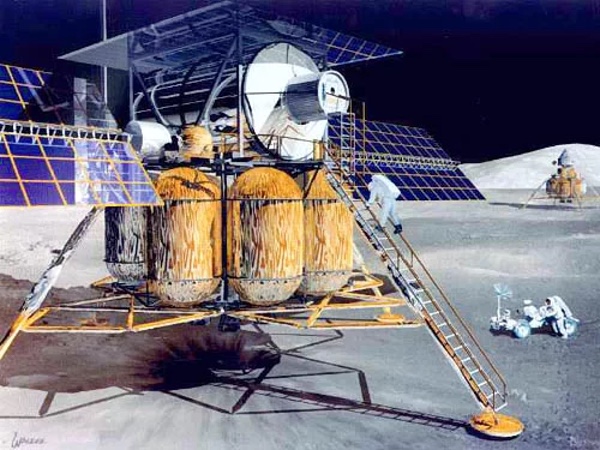 The First Lunar Outpost proposal would have used the same lander in two configurations: the human vehicle that transported the astronauts to and from the Moon, and the habitation module which would have allowed them to stay on the surface for up to 45 days.(credit: NASA) |
Landers for FLO
One of the design guidelines for FLO was to reduce lunar surface operations required to activate the lunar outpost. This would reduce crew support requirements on the transportation system and allow crew time to be devoted to science and resource studies. Another design guideline was to have the human and habitat module flights use the same translunar injection and lander elements. Finally, the landers were to use as much existing equipment as possible to reduce development costs.
FLO involved the use of two kinds of lunar vehicles: a habitat module and a crewed lander. Both vehicles would use essentially the same landing stage to minimize complexity and would have a gross mass at trans-lunar injection of 95,760 kilograms. The habitat lander would weigh 56,796 kilograms and the piloted lander 56,588 kilograms. They would carry their cryogenic propellants in eight main propellant tanks. Each would carry 43,954 kilograms of fuel. The landing stage would be 7.1 meters tall and have a span with its landing legs deployed of 18.8 meters wide. The piloted lander would stand 14.1 meters tall and the astronauts would descend by a vertical ladder to a platform on the lander stage before descending down a sloping stair ladder to the surface.
Each FLO flight would require a single launch. The landers would be powered by four engines derived from the highly dependable RL10 engine used on the Centaur upper stage. The habitat module would utilize a cylindrical module then under development for Space Station Freedom. It would be launched to the Moon and land automatically with two-kilometer accuracy. It would then autonomously deploy two large solar panels, radiators, and other antennas, and await the arrival of the crew—the goal was to allow the astronauts to land and instantly set up shop, rather than requiring them to build facilities as envisioned by the original Space Exploration Initiative plans. The overall width of the vehicle with its solar panels deployed on the lunar surface would be 41.1 meters. The habitat module would also be equipped with regenerative fuel cells to provide power during the 14-day lunar night. During the daytime, electricity from the solar cells would be used to separate water into hydrogen and oxygen, and during the night the fuel cells would combine them, producing electricity and water.
Once the habitat module was operating, the crewed spacecraft with its four-person crew could be launched to the Moon. The transit time would be slightly over four days. It too would land automatically, because the astronauts would have no view of the surface during touchdown.
The crewed spacecraft would be designed for a 45-day stay on the Moon and would utilize storable propellants for its ascent stage. It would have to be able to carry five metric tons of supplies and would be capable of returning its four-person crew and 200 kilograms of cargo to a land landing on Earth. The crew module itself would be an Apollo capsule shape but increased by 5% for larger crew and EVA suits. The capsule would have a thermal protection system consisting of both tiles and ablatives, and would have a parachute and retrorocket deceleration system, like the Russian Soyuz.
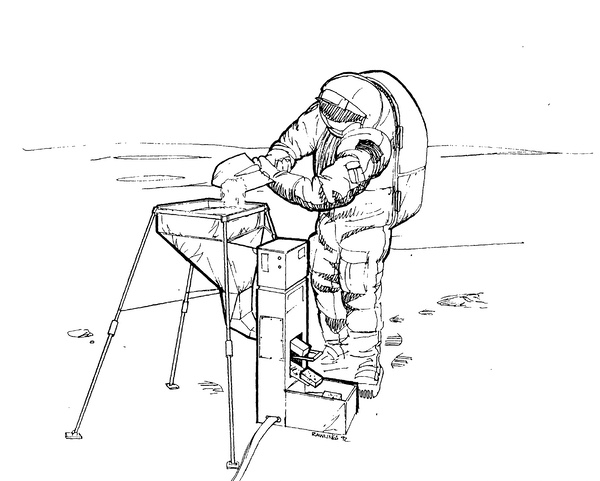 In 1992, NASA conducted workshops to outline what astronauts would do on the lunar surface as part of the First Lunar Outpost mission concept. Some experiments were extensions of those done during Apollo, whereas others were new, such as in situ resource utilization proof of concept experiments, considered vital to continuing future human exploration missions.(credit: NASA) |
Mission to Mare Smythii
The initial landing site that the FLO team selected was Mare Smythii, near the equator on the eastern limb. This was merely a baseline, “strawman” mission intended to outline the types of operations that a crew could perform on the Moon. The team also evaluated an alternate site at the Aristarchus Plateau at 23 degrees north, 48 degrees west to determine if it made any significant difference in the reference mission. They concluded that except for some specialized sites, such as the lunar poles, the bottoms of craters, or other unusual terrain, the mission science payload and the EVA activities would not change much from site to site. The FLO team acknowledged that the actual landing site and scientific missions would be selected by appropriate committees, panels, and representatives from the respective science disciplines.
| The First Lunar Outpost was in many ways a very conservative approach to returning to the Moon. It did not rely upon any major new technologies. |
After the crew touched down and settled into their habitat module, they would conduct nine looping traverses using an unpressurized four-person lunar rover. They would drive out a maximum of 25 kilometers from base, visiting all major features and gathering detailed geologic data from an area about 50 kilometers around the outpost. Each traverse was divided into segments suitable for one eight-hour EVA on the rover. The initial timelines indicated that about five or six of the traverses could be completed on one mission. The remainder would be left for future missions. One of the plans for FLO was to leave the habitat module unattended on the surface for up to six months.
The science and payloads team determined that there would be four major scientific disciplines conducted during the mission: astronomy, geophysics, life sciences, and space and solar system physics. The astronauts would deploy instruments on the surface, some of which required human tending and others that were “set and forget.” The payloads were:
- Geophysical Monitoring Package
- Solar System Physics Experiment Package
- Traverse Geophysical Package
- Lunar Geologic Tool Set
- Lunar Transit Telescope
- Small Solar Telescope
- Robotic Package for Rover
- Life Science Package
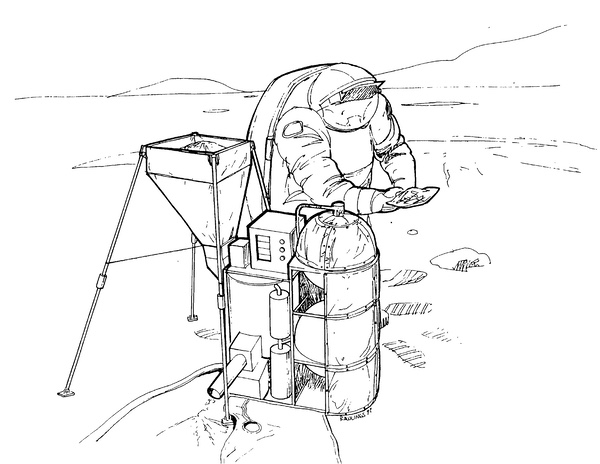 In 1992, NASA conducted workshops to outline what astronauts would do on the lunar surface as part of the First Lunar Outpost mission concept. Some experiments were extensions of those done during Apollo, whereas others were new, such as in situ resource utilization proof of concept experiments, considered vital to continuing future human exploration missions.(credit: NASA) |
The heaviest payload would be an In-Situ Resources Utilization (ISRU) Demonstration Package. The ISRU package would consist of various experiments for the astronauts to demonstrate the use of resources on the Moon, such as heating lunar regolith to extract oxygen. NASA considered that successfully demonstrating this capability was vital to any future long-term presence on the Moon.
The second mission would have different science goals. The crew would complete the traverses not performed on the first mission and begin a detailed drilling program with a ten-meter drill using data from the traverses to determine optimum drilling locations within 20 kilometers of the outpost. They would also bring and deploy the initial elements of a radio telescope array and revisit the optical telescope site and switch detectors as an operational test.
The mission would require a new spacesuit that improved mobility and required less maintenance than the existing space shuttle suits. The suits would also not require the astronauts to pre-breathe oxygen to avoid the bends as a result of nitrogen bubbling in the bloodstream. This pre-breathing technique, common to American EVA procedures, would be too disruptive of the lunar exploration schedule and would make things like emergency EVAs impossible.
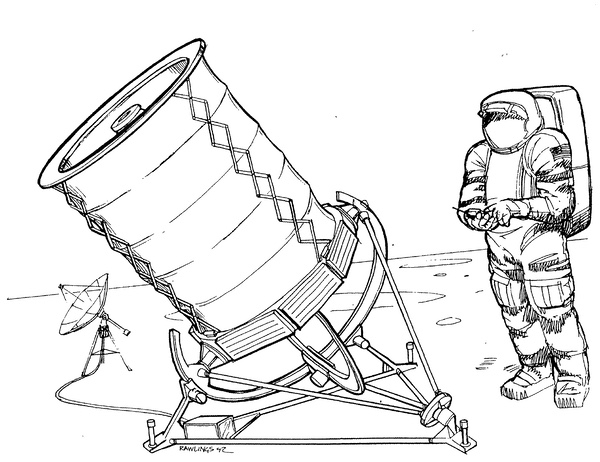 In 1992, NASA conducted workshops to outline what astronauts would do on the lunar surface as part of the First Lunar Outpost mission concept. Some experiments were extensions of those done during Apollo, whereas others were new, such as in situ resource utilization proof of concept experiments, considered vital to continuing future human exploration missions.(credit: NASA) |
Reducing costs
The First Lunar Outpost was in many ways a very conservative approach to returning to the Moon. It did not rely upon any major new technologies. Although it would have required a massive new launch vehicle, key parts of that launch vehicle—the engines—represented no technical risk. Reusable spacecraft, although possibly cheaper in the long run, also posed significant development risk and so FLO avoided them. Most of the technology for the mission already existed. Certainly, designing and integrating new systems based on this technology would not be easy, but there is no reason to believe that this would be particularly troublesome.
FLO avoided reliance upon the shuttle, and if the shuttle and space station programs continued, launch operations at Kennedy Space Center would have presented numerous problems. For example, two FLO launch vehicles would have to enter integration and processing at the same time, and the Vehicle Assembly Building, which had originally been designed for a higher launch operations tempo that had never been tested, would have been pressed to the limits to accommodate both FLO launch vehicles as well as ongoing shuttle flights.
| Goldin was in some ways fighting to preserve human spaceflight’s very existence, and it was clear that future human space exploration beyond low Earth orbit was not on the agenda. |
NASA apparently did not produce a cost estimate of the First Lunar Outpost at the time that it was announced because the agency had not performed enough engineering work. However, in 1993 Kent Joosten of NASA’s Johnson Space Center and Lisa Guerra of Science Applications International Corporation presented an alternative lunar exploration plan that included an independent estimate of FLO costs. According to Guerra and Joosten, FLO would cost $25 billion (1993 dollars) through 2005, the time of the first mission (as opposed to the original goal of 2000). Fifty percent of this cost—$12.6 billion—would be required to build the new heavy-lift launch vehicle. The space transportation systems would cost $7.3 billion, habitation systems would cost $2.1 billion, surface systems would cost $1.9 billion, and science payloads would cost $1.1 billion.
Joosten and Guerra proposed that by using lunar resources early in the exploration program, they could reduce the amount of payload that had to be lifted to the Moon. This would allow the use of a smaller launch vehicle that was less expensive to develop. They labeled their proposal LUNOX for its reliance upon lunar oxygen. But the LUNOX proposal received far less detailed attention than FLO.
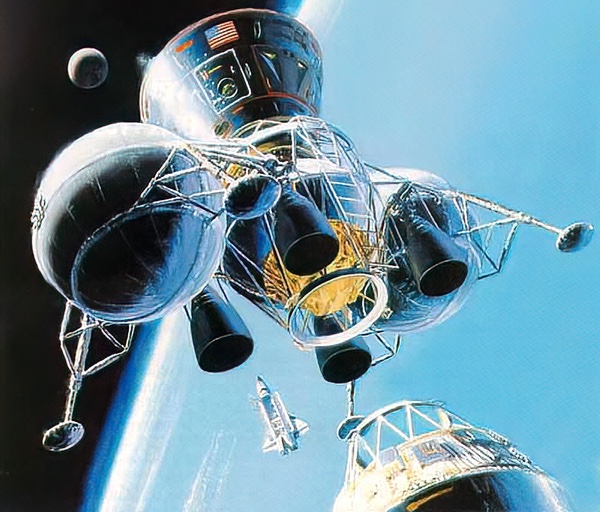 A proposed less expensive lunar landing mission from the early 1990s. This was created in response to the expense of NASA's 1992 First Lunar Outpost mission proposal. It would have required multiple space shuttle and Titan IV launches. |
Too much, too late
By the time NASA unveiled FLO, the Space Exploration Initiative was dead politically, although some at the Space Council had begun other efforts to shake up the NASA establishment, often through backdoor channels. In early 1992, several former Space Council staffers initiated the Clementine spacecraft under the sponsorship of SDIO. Although officially intended to demonstrate technologies necessary for space-based missile defense, the spacecraft’s proponents had ulterior motives, intending to use the inexpensive probe to embarrass NASA officials by gathering science data from lunar orbit at a fraction of the cost of a typical NASA mission. In 1994 Clementine did exactly this.
In 1992, the presidential election was also in full swing. George H.W. Bush lost that election, and in January 1993 William Jefferson Clinton was sworn in as his successor. During the early months of the Clinton Administration Dan Goldin’s future at the space agency was in doubt and he faced open revolt from several of the agency’s top civil servants.
After it was clear that Goldin would remain at the space agency—if only because the new administration could find nobody to replace him—Goldin devoted his attention to securing a commitment from Clinton to the space station, and to bringing Russia into the program. He was ultimately successful at both of these efforts. But Goldin was in some ways fighting to preserve human spaceflight’s very existence, and it was clear that future human space exploration beyond low Earth orbit was not on the agenda.
After the embarrassing failure of the expensive Mars Observer spacecraft in fall 1993, Goldin was able to substantially overhaul robotic planetary exploration and introduce “faster, better, cheaper” development techniques into the agency’s robotic efforts. NASA became focused on flying the shuttle, building the space station, and reducing costs for various agency missions. Discussion of sending humans back to the Moon or to Mars now primarily occurred outside of the agency but continued at low levels throughout the 1990s.
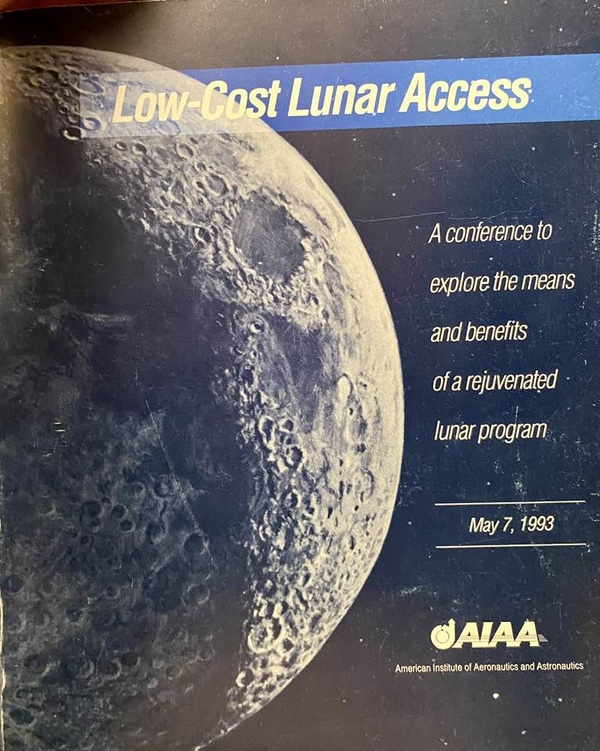 In 1993, the American Institute of Aeronautics and Astronautics held a one-day symposium on lower cost lunar missions. The 1989 “90-Day Study” had proposed a very expensive, multi-decade plan for lunar exploration. The 1992 First Lunar Outpost study had looked at a much simpler first step toward lunar return, but it still would have had a very expensive price tag. Several studies following FLO sought to reduce costs further, but most of them relied upon existing, expensive launch vehicles. |
The quest for cheaper space exploration
FLO had been intended to serve as a baseline, and it was now clear to industry that cheaper alternatives to NASA’s projects were necessary. In 1993, the American Institute of Aeronautics and Astronautics held a “Low Cost Lunar Access” symposium to consider cheaper ways of returning Americans to the Moon. General Dynamics unveiled its “Early Lunar Access” proposal. Rather than two Saturn V-plus class vehicles for each mission to the Moon, the General Dynamics proposal would have required four launches: two Titan IVs and two space shuttle launches. Guerra and Joosten also proposed a method of using lunar resources to reduce launch mass requirements. They calculated that this approach could save up to $6 billion compared to FLO, but with greater technical risks, such as the requirement for a nuclear reactor and development of processing equipment for the lunar regolith.
Many of these proposals faced an unfortunate conundrum: the largest launch vehicles in the American fleet, the space shuttle and Titan IV, were still not big enough for even dual-launch lunar operations. Even if the shuttle carried part of the spacecraft into orbit and then rendezvoused with another part carried into orbit atop a Titan IV, the performance margins were so tight that they would force safety compromises. A third launch would add significant cost and complexity, because neither the shuttle nor the Titan IV could be launched in rapid succession. There were no easy solutions that did not require, for instance, a new rocket vehicle with greater power than either shuttle or the Titan IV.
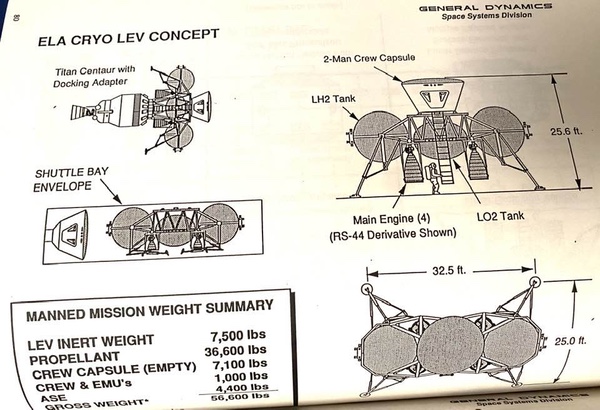 General Dynamics proposed a lunar vehicle to “supplement” FLO. It would have used both the shuttle and Titan IV. |
In addition, the entire political environment that had framed American space policy for decades was changing. With the Cold War over, competition with the remnants of the Soviet Union turned to cooperation. Soon NASA’s budget was being cut as the Clinton Administration sought to use the money elsewhere. In 1989, President Bush had declared that his goal was to achieve American preeminence in space. That goal could now be achieved at far less cost because, in the 1990s, nobody was challenging American space preeminence.
| In 1989, President Bush had declared that his goal was to achieve American preeminence in space. That goal could now be achieved at far less cost because, in the 1990s, nobody was challenging American space preeminence. |
There were other proposals that sprouted from the failure of SEI. In 1990, Martin Marietta engineers Robert Zubrin and David Baker produced an innovative plan for a Mars mission called Mars Direct. Most of the concepts used for Mars Direct dated from earlier NASA research, and the project at Martin Marietta was initiated by the company to secure SEI contracts. Throughout the 1990s Zubrin worked tirelessly as a zealous advocate of the plan, which he claimed would be significantly cheaper than NASA’s more conventional Mars approach—although it still would have required development of a nuclear reactor capable of operating autonomously on Mars, along with untried in situ resource utilization technology. Another lunar proposal developed within NASA in 1993 called LUNOX also would have used in situ resources to lower costs, compared to the First Lunar Outpost, to $19.6 billion. Its primary benefit was that it no longer required a Saturn V-class launch vehicle.
Starting in 1995, NASA administrator Dan Goldin challenged industry and NASA personnel to develop a human lunar landing spacecraft under a “faster, better, cheaper” approach. This effort was labeled Human Lunar Return, or HLR, and had a tight schedule, calling for a human landing on the Moon by 2001. The plan that agency personnel produced required developing precursor technologies that would also be used after the initial landing and would have a total cost of $4.17 billion. Not included in this cost, however, were the launch costs, which would have been significant: eleven large Titan IV-class launch vehicles, two Delta II-class launch vehicles, and one Taurus-class launch vehicle, plus several shuttle launches. Those launches would have at least doubled the overall cost.
Goldin was unhappy with the costs and wanted his people to bring them down substantially. This forced a revision of the plan that further cut safety margins. But by 1996 the entire effort was abandoned as Goldin and NASA turned more attention to robotic Mars exploration and the problems of the space station and the shuttle.
The initial HLR estimates were far cheaper than the SEI costs only six years earlier, and in fact cheaper than the First Lunar Outpost costs of 1992. However, as one observer noted, during this period NASA’s cost estimates for human spaceflight were notoriously unreliable and it is doubtful that the project could have been pursued at anywhere close to these estimates. Still, the space agency had produced many plans for lunar missions that would not cost $100 billion.
Once the HLR effort was abandoned in 1996, NASA continued to conduct internal studies of human Mars and lunar exploration, such as the Mars Design Reference Mission in 1997 and Project NEXT in 2002. But nobody at NASA pretended that these were anything other than viewgraph engineering, lacking high-level support. It wasn’t until the Columbia accident in 2003 that the political environment shifted, making it possible for the political leadership to again think about taking America out of low Earth orbit.
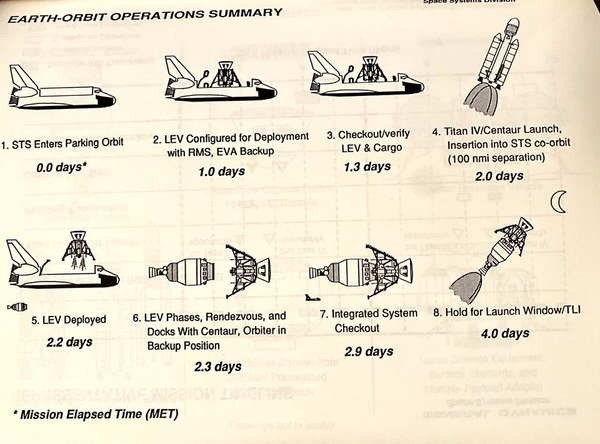 The dilemma facing designers of future human lunar missions was that they either had to use existing, expensive launch vehicles which were not ideal for reaching the Moon, or develop new, larger launch vehicles as well as new technologies at considerable expense. There were no inexpensive and simple ways of sending humans back to the Moon. |
Revisiting SEI
There are multiple ways of interpreting the Space Exploration Initiative as well as its failure. Was it a poorly conceived concept that did not take into account the political environment as well as the ability of NASA to undertake such a major project? Was it a well-intentioned effort to reinvigorate the American human spaceflight program that ran into bureaucratic inertia and opposition? Could it have succeeded to some extent if there had been different approaches or personalities involved? Even without NASA opposing SEI or being incapable of developing realistic ways to implement it, the agency was already struggling to develop the space station, which had slowly gained domestic and international support throughout the 1980s, and SEI posed a threat to the space station coalitions that had taken years to build.
It has been over three decades since George H.W. Bush stood on the steps of the National Air and Space Museum and announced his plan to return humans to the Moon. Not only has the United States still not sent humans beyond low Earth orbit, but the record of lunar exploration since then remains thin. Only three robotic spacecraft, all Chinese, have landed on the lunar surface since the 1970s. Other efforts have been canceled or failed. This fact alone implies that lunar exploration, even robotic exploration, is neither easy nor inexpensive.
Eighteen years after the second President Bush announced plans to return humans to the Moon, America is still struggling to accomplish that goal. That recent history is more complex and convoluted than the demise of the 1989 Space Exploration Initiative. It is, however, equally depressing.
Note: we are using a new commenting system, which may require you to create a new account.
